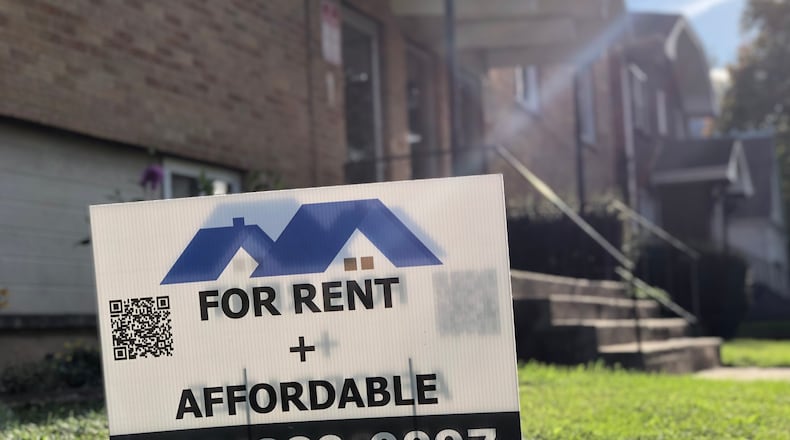Housing issues are complicated, but the authors of the report and some local nonprofits say private-public partnerships can be part of the solution. Millions of dollars in federal funds are headed this way that they hope can be put toward expanding the affordable housing supply.
“Any solution to address housing in the Dayton area will have to involve the combination of new construction, adaptive reuse of existing buildings like a vacant school, church or office building, and the preservation of existing housing,” said Patrick Bowen, president of Bowen National Research.
Earlier this year, the Miami Valley Non-Profit Housing Collaborative hired Columbus-based Bowen National Research to complete a housing-needs assessment for Dayton and Montgomery County.
The assessment is supposed to help stakeholders and the housing collaborative’s partners make “informed strategic decisions” about housing priorities, plans, spending and policies.
Partners include County Corp, Greater Dayton Premier Management, Habitat for Humanity of Greater Dayton, Miami Valley Community Action Partnership, Miami Valley Housing Opportunities, Rebuilding Together Dayton and St. Mary Development Corporation.
Credit: Cornelius Frolik
Credit: Cornelius Frolik
The nonprofit groups say this assessment is completely new and provides valuable information based on research about the local housing market at a time when federal funds are flowing into the community.
“The Miami Valley Non-Profit Housing Collaborative’s housing needs assessment is a prime example of the collective effort under way to create lasting and impactful housing policies and procedures for our area,” said Jennifer Heapy, CEO of Greater Dayton Premier Management, the local public housing authority.
By 2026, the city of Dayton will need more than 3,800 new rental units and 4,600 new units that are for sale to meet demand, the assessment says.
The rest of the county could support 4,800 new rentals and 7,100 that are for purchase.
Nearly half the new rental product in Dayton should cost no more than $950 per month, which is roughly the affordability limit for households at or below 50% of area median income ($37,850), the report says.
Lower-cost residential options also would help the three in five renter households in the city that earn less than $30,000 annually, according to the assessment.
Half of Dayton’s renters are cost burdened, which means they spend more than 30% of their income on housing costs. More than one-quarter are severely burdened, meaning more than half of their income goes toward housing.
In the rest of the county, 38% of renter households are cost-burdened and the same share also earn less than $30,000 per year. About 18% of renters in the county, outside of Dayton, are severely cost-burdened.
Rent-burdened households have higher eviction rates, increased financial fragility and are more likely to rely on social safety-net programs than other renters and homeowners, said Adam Blake, vice president of housing with County Corp.
Blake said heavy housing costs are linked to food insecurity, child poverty and worse health outcomes, and there is a large and growing gap between the share of white and Black households that are severely cost-burdened.
Blake said he believes the community can add as much new housing as recommended in Bowen report.
He said the community could receive millions of dollars in disaster recovery funding to help recover from 2019 Memorial Day tornadoes, which he says could support multi-family rental projects in hard-hit areas.
Blake also said the city is going to receive $138 million in federal rescue funds that also could help create new affordable housing. Many community members who provided feedback to the city about how it should spend its federal funds said they support new housing projects.
Wages are not keeping up with rising rents and housing costs, and the Bowen report also shows that many people live in substandard housing, said Keelie Gustin, chief policy officer with Miami Valley Community Action Partnership.
The assessment says that more than 3,000 housing units in the county are overcrowded, and about 1,755 lack complete kitchens or indoor plumbing.
“Overall, we are incredibly worried about the availability of affordable housing as this area continues to transform,” she said.
Gustin said local groups and agencies can partner together to advocate for and work toward expanding the local affordable housing inventory.
She said there is demand for maintenance-free apartments and condos and amenity-rich projects and product that allow seniors to downsize and millennials to raise families.
But she said low-to-moderate income households really need more housing options.
Building new units is important, but so is preserving existing housing stock, said Amy Radachi, president and CEO of Rebuilding Together Dayton.
The Bowen assessment says most owner-occupied housing units in the county were built more than 50 years ago, which means many may need repairs, modifications and modernization.
The study also projects that in the next five years there will be sizable growth in households headed by residents 75 and older.
Radachi said her organization assists seniors with home repairs and modifications that allow them to age in place in a safe and healthy environment.
“We see the need increasing every month and need the resources necessary to continue to stabilize our community and our seniors,” she said.
About the Author


